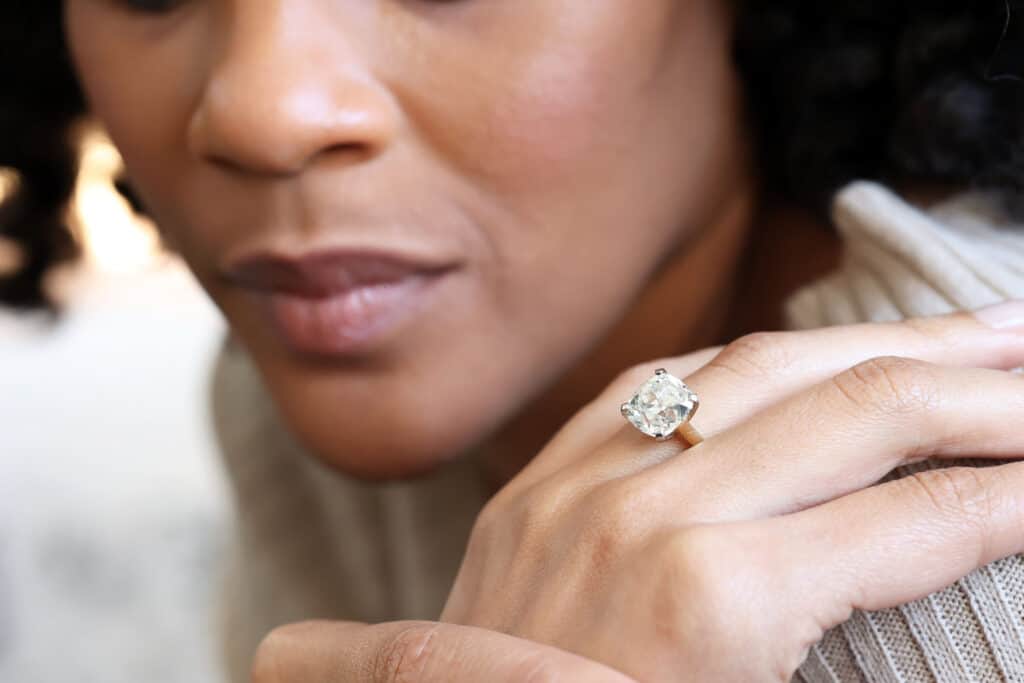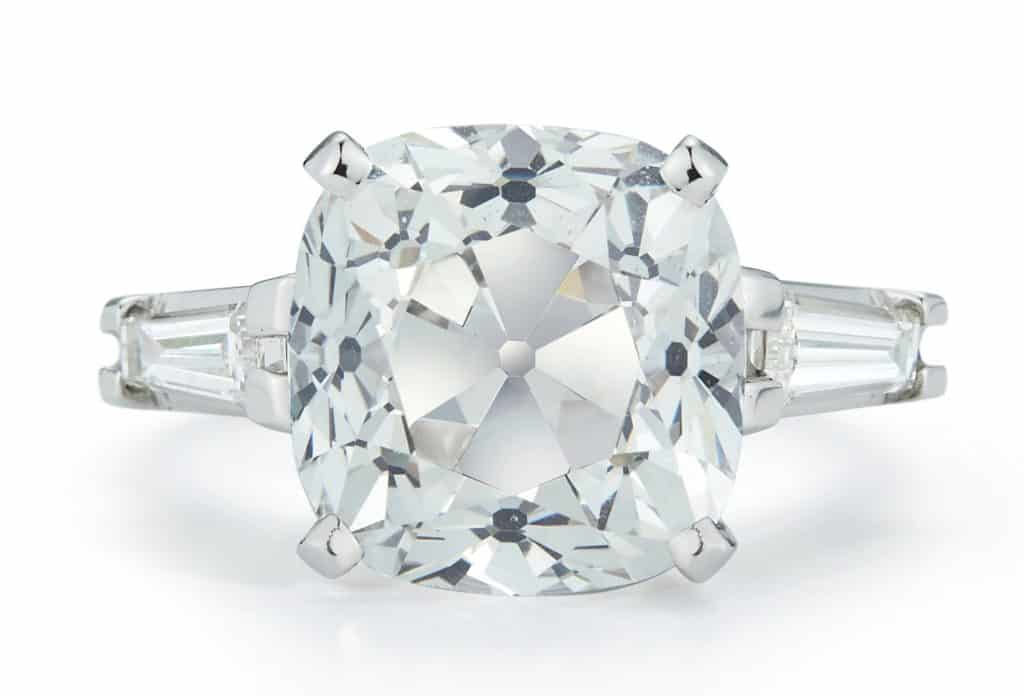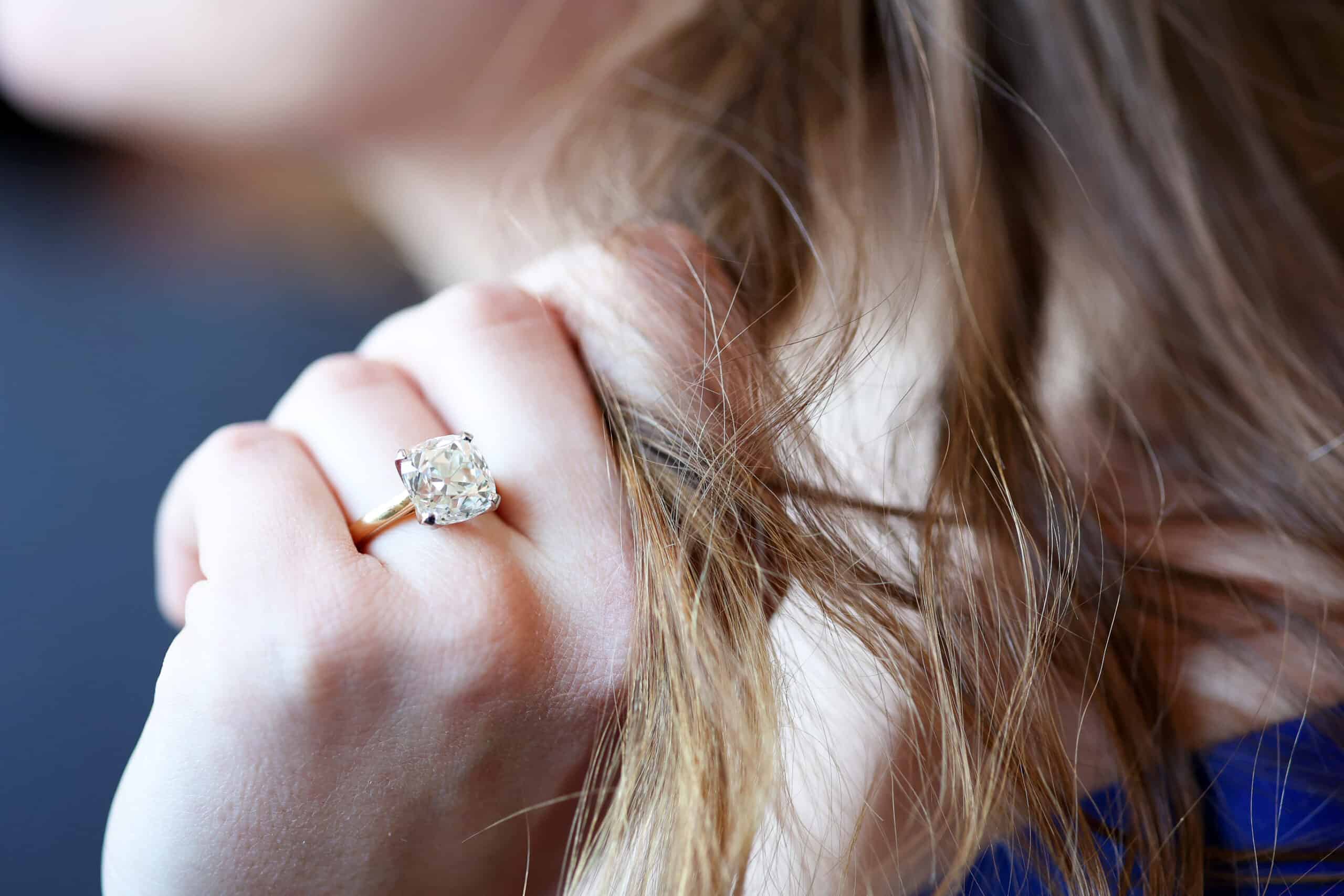Old Mine Cut Diamonds
A guide to old miner diamonds and which qualities you should focus on
We are reader-supported. Buying through any red colored link on our site may earn us commissions. Learn More.
A guide to old miner diamonds and which qualities you should focus on
Characterized by their cushion-like shape, high crown, and large facets, Old Mine Cut diamonds were originally crafted in the late 17th to early 20th centuries. They typically feature 58 facets, but what sets them apart is their uneven and less symmetrical arrangement, giving them a unique, “softer” sparkle compared to the brilliance of modern cuts. When looking to purchase an Old Mine Cut diamond, consider factors like the Four Cs—cut, color, clarity, and carat weight—but also pay attention to the diamond’s proportion and symmetry. The quality of the cut can greatly affect the stone’s appearance, making it important to choose a well-cut stone for optimal sparkle.
In terms of budget, Old Mine Cut diamonds can vary widely in price, depending on factors like size, quality, and rarity. They are generally less expensive than modern brilliant cuts but can still fetch high prices, especially if they are of high quality and have historical significance. Prices can range from a few hundred dollars to thousands per carat. These diamonds are most commonly found in antique jewelry pieces like engagement rings, brooches, and earrings, making them a romantic and timeless choice for those captivated by the charm of yesteryears.

What is an old mine cut diamond?
What is the history of an old mine cut diamond?
How much does an old mine cut diamond cost?
What is the difference between an old mine and old European cut?
How does an old mine cut differ from a modern round brilliant cut?
Tips for buying an old mine cut diamond
Why you should trust us
Bottom Line Recommendation:
Old mine cut diamonds have a beautiful appearance that dates back to an era when diamonds were cut and polished by hand.
Like other antique diamonds, old mine cut diamonds have a softer look than modern diamonds, with large facets that produce unique fire. They often also have the beautiful imperfections that give antique diamonds so much character.
If you’re searching for an old mine cut diamond for an engagement ring, we recommend buying from Abe Mor Diamonds, who specialize in antique cut diamonds and have a diverse selection of high-quality diamonds and settings available. For more help, you can also contact us.
Old mine cut diamonds are a type of antique diamond. Unlike modern diamonds, which are cut and polished using high-tech equipment, old mine cut diamonds were cut by hand, giving them a charming, warm look that many people love about antique diamonds.
According to the GIA, the term “Old Mine Cut” like came into use in the 1800s when diamond production in Africa began to eclipse production from the ‘old mines’ in India and Brazil.
You might see the old mine cut referred to online and in some diamond guides as the “miner’s cut.” This diamond cut was used extensively throughout the 18th and 19th centuries in a wide range of diamond rings and other jewelry.
Aesthetically, old mine cut diamonds share some similarities with modern diamonds. They also have several key differences that give them their unique appearance.
Old mine cut diamonds have a square shape with soft, slightly rounded corners. From above, a typical old mine cut diamond will have an outline that’s somewhat similar to the modern cushion cut diamond.
However, there are also several major differences between old mine cut diamonds and modern diamonds. We’ve explained these, and more, below.

This email
Old mine cut diamonds share some features with certain modern cut diamonds. However, they also have several major differences. Visual characteristics of the old mine cut include:
Placed next to a modern diamond, the proportions of an old mine cut diamond can look overly large and bulky at first glance.
However, this is all a deliberate part of the diamond’s design. Unlike modern diamonds, which are cut to look beautiful in any setting, old mine cut diamonds were cut to be viewed under the candlelight and offer a unique warm appearance, with a soft, romantic glow.

Old mine cut diamonds date back to the early 18th century. During this period, diamonds were cut and measured by hand, with the diamond cutter’s skill and perception playing a key role in each diamond’s proportions, appearance and overall beauty.
The old mine cut was particularly popular during the Georgian, Victorian and Edwardian eras — in fact, it was arguably the most popular diamond cut of all from the early 18th century until the last few decades of the 19th century.
In the late 19th century, the old European cut — a transitional cut between the old mine cut and the modern brilliant cut — became a more popular choice.
Unlike modern diamond cuts, which tend to have names that are directly related to their shape, the name “old mine cut” can seem like a bit of a mystery to would-be diamond buyers.
Instead of being related to the diamond’s shape, the name “old mine cut” comes from the origin of rough diamonds commonly used in 18th and 19th-century jewelry. Explaining this requires a quick history lesson on the early diamond industry.
Up until the late 19th century, the vast majority of diamonds used in jewelry were sourced from mines in India and Brazil.
India was the world’s first large-scale source of diamonds. Diamonds were mined in India from ancient times, with mining-focused Indian cities such as Golconda gaining a reputation abroad as places of large, stunning diamonds and immense wealth.

In 1724, diamonds were discovered close to the modern city of Belo Horizonte in Brazil. Brazil quickly became another major supplier of diamonds.
Throughout the 18th century, India and Brazil were the two main sources of diamonds used in jewelry. Then, in the 1860s, diamonds were discovered in South Africa, resulting in a massive boom in diamond mining throughout the African continent.
Originally, the term “old mine” referred to diamonds sourced from mines in India or Brazil — at the time, the “old” mines of the diamond industry. Over time, it was used to refer to diamonds from any country that used this old-style cut.
Old mine cut diamonds remained popular until fairly late in the 19th century, after which the old European cut became the most popular diamond shape.
By the early-to-mid 20th century, as diamond measuring and cutting technology became more precise and advanced, both antique diamond cuts were largely phased out in favor of modern diamond shapes such as the round brilliant cut.
As with other diamond shapes, the value and price of an old mine cut diamond can vary based on its carat weight, color, clarity and the quality and beauty of the diamond’s cut. Old mine cut diamonds are generally 10 to 15 percent less expensive than the old European cuts. You can get an inferior 0.40ct for only $300 or a gorgeous 2ct for $5,500.
Until recently, old mine cut diamonds and other antique diamonds sold for slightly less than modern diamonds. This is because they were often recut into modern shapes — a process that resulted in part of the original diamond going to waste.
Today, antique cut diamonds are in demand specifically because they’re old and unlike modern cuts, meaning they tend to sell for similar prices to equivalent diamonds in modern cuts.
Many old mine cut diamonds were cut and sold a long time before diamond engagement rings became a mainstream piece of jewelry. As such, they’re often larger than most diamonds used in modern engagement rings — one of several factors that can affect their value.
If a diamond is of historical or cultural significance, it may also command a premium compared to other antique and/or modern diamonds.
Unlike modern diamonds, old mine cut diamonds were cut and polished long before precision diamond cutting equipment was available. As such, you can often find asymmetrical features and imperfections in old mine cut diamonds.
For a modern diamond, an asymmetrical cut can seriously harm its value. However, this is less of a factor with an antique diamond such as an old mine cut. For many buyers, a diamond with a slightly imperfect cut might have more beauty and character than a perfectly cut stone.
Beyond these factors, antique cut diamonds like the old mine cut are valued the same way as most other diamonds, by assessing their color and clarity grades.
| Carat Weight Range | Price Per Carat |
| 0.5 to 0.69 ct | $1,800 to $2,000 |
| 1 to 1.4 ct | $2,700 to $3,300 |
| 1.5 to 1.99 ct | $3,300 to $4,100 |
| 2 to 2.99 ct | $4,500 to $5,800 |
If you’re interested in buying an old mine cut diamond and have a specific budget in mind, feel free to contact us for expert help.
The old mine cut is sometimes compared to old European cut — another antique diamond cut that’s gained in popularity over the last decade. Although both of these diamond cuts share a few features, there are also several key differences:
With these differences out of the way, there are also several major similarities between the old mine cut and the old European cut.
First, both diamonds feature 58 facets, although they’re cut quite differently. Both diamond cuts also have a softer, less brilliant appearance than modern brilliant cut diamonds, giving them an elegant, classic appearance that’s subtle and less likely to draw overt attention.
The old mine cut is also occasionally compared to the round brilliant cut — the most common modern diamond shape. Although they share a few similarities, the old mine cut and modern round brilliant cut are very different diamond shapes with numerous differences:
Unlike buying a modern diamond, shopping for an old mine cut diamond isn’t quite as simple as you’d think. Because these diamonds are antique and no longer produced, the supply is limited, with only a few diamond vendors offering them.
Below, we’ve offered our expert tips to help you successfully buy an old mine cut diamond while getting the best possible deal:
Don’t know where to start? If you need personalized help finding and buying the right diamond, engagement ring or other jewelry, feel free to contact us.




Before you buy a diamond, get personal buying advice from industry veterans. We'll help you get the best diamond for the money.
DISCLAIMER: We don't use your email for marketing. Period.
A diamonds’ price is determined primarily by the 4 Cs of the diamond. On the wholesale level, diamond prices are first based on a diamond shape and
Buying an engagement ring is often one of the first major purchases in a person's life. The process can be fraught with tension as there are so m
A wide range of 1 carat diamonds exist both in online markets and local diamond jewelry stores. Not only are there significant differences in beauty
Please enter your email address to receive your 25% off coupon code:
Here is your coupon code: GFDSF3GF